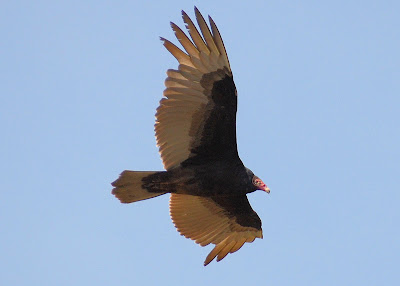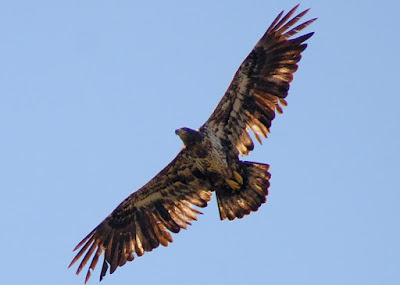Early this spring I was asked to photograph an event that took place at Allatoona Lake dam. The Corps of Engineers were hosting a local museum society by giving a talk on the history of the dam as well as a tour of it, both inside and out. While on top of the dam I was trying to find a good angle to capture the ranger giving the talk as well as his audience. I got up against an exterior wall that overlooked the Etowah River, which is what the dam discharges to, and got my shot. But before moving to my next shot I took the opportunity to enjoy the view.
Besides being a long way down, there were a lot of wildlife present in the form of birds. What particularly caught my attention were a pair of Osprey that were building a nest. This nest was being constructed atop a telephone pole installed by Georgia Power (just one of many they put up around the lake for nesting purposes). A platform atop the pole to act as a base for the nest is a surplus WWII cot. These cots were discovered in a store room in the dam. They were assumed to be left over from the time of construction of the dam (1940's). Pretty clever repurposing of something that had just been occupying space for 50+ years.
Not only had I discovered this pair of Osprey while building their nest, I also observed the moment they started a family.
Having obtained these first shots spurred me to want to document this pair of Osprey's raising a family. I'm no pro and I don't have fancy video equipment with awesome lenses but I wanted to do what I could with the equipment I have. Which is a 24mp DSLR, an 18-300 mm zoom lens and a tripod. Not even close to ideal for serious wildlife photography. But with a little help from some good photo editing software it will look good in my photo library.
Here's what the photo above looked like before cropping, enlarging and digital enhancing:
Distance was the biggest challenge to this project. My subjects were in the wide open and most of the time lighting was excellent. But the nest was so far away that even with a tripod it was hard to get a crisp image. Between the wind and natural vibrations in the dam I just couldn't get a steady image with the exposure times needed.
This is a shot that I think conveys just how far away the nest was:
That first photo at the top of the page was on a cold, cloudy day in mid-March while there for another purpose. I had to campaign my volunteer supervising ranger to get permission to enter this extra-secure area to do follow up photos. Fortunately he agreed and got the okay from the civilian contractors that operate the power house (this dam does flood control and power generation). So now all I have to do is check out keys to get me through the chained and padlocked gates with razor-wire tops and set up without the worry of being shot.
Between my volunteer duties and weather I was able to return once or twice a week at first and then about every 7-10 days as we got into the busiest part of the summer recreation season.
A week after the first photo finds our expecting parents sorting out fishing duties and eating priorities. Despite no eggs or chicks in the nest the pair have brought food to the nest to eat. After observing for about a half hour it was obvious that the female was in no mood to share. But this didn't deter our dad-to-be, he just kept trying to get a bite in, albeit unsuccessfully.
Ten days in from mating and small improvements in the nest continue. The female is spending more and more time on the nest while the male seems to be spending a lot of time hanging out and soaring with the turkey and black vulchers.
Eleven days after the first picture and a single egg appears.
While mom was taking care of business at the nest, dad was out gallivanting around.
My first visit in April found mom sitting the nest. However she seemed tense and was keeping a wary eye to the sky directly above her.
Her wary eye to the sky was for good reason, the air was full of flying creatures - turkey vultures, black vulchers, crows, ospreys and an eagle.
CLICK ON PHOTO TO ENLARGE
 |
This is another osprey. He was circling low, at the same elevation as the nest.
That's the dam in the background. |
 |
Our intrepid father of the egg got airborne and joined up with
some crows that were making a noisy fuss. |
 |
Turkey Vulcher.
These guys look like a giant bomber coming in. |
 |
| And here we have a Black Vulcher. |
 |
It doesn't look like it but this is a Bald Eagle.
This is a juvenile (less than 5 years old) so no white head yet.
It is also in what appears to be a full blown molt. |
 |
Yet another Osprey has joined the soarers above the dam.
This one was hamming it up for the camera as he kept circling
closer and closer until we were practically eye to eye. |
 |
| Looking right down the barrel of the lens! |
 |
| I liked this one because of the airplane silhouetted in the distance. |
Mid-April I happened to time my arrival with a shift change at the nest. The male was finishing up his sitting duties and turning them over to the female. In this transition there was a chance for a good look at the nest that hasn't been possible recently because the pair have been sitting almost constantly. With this new look I was able to see that instead of one egg there were now three. I don't know if it is common for eggs to be laid so far apart but that is what is going on in this nest.
I made many visits to my perch atop the dam over the next couple of weeks hoping to catch a hatching. But all I got was one of the parents, mostly the female, sitting on the eggs. Not too exciting. Then, about mid-May I noticed the female had a different posture than usual. She was holding her body up a little and spreading her wings ever so slightly. But she never moved from this position in the two hours I kept watch. A couple days later when I was able to get back, BINGO, chicks in the nest.
In the photo above it was hot in the direct sun and the female was adjusting her position when I got a look at the fuzzy little balls. Because they are so hard to make out in the photo (the limitations of my equipment are really showing) I have drawn a red line around the one, most distinguishable head.
All three of these chicks appeared to have hatched within the last 48 hours, can someone tell me how the heck the egg laid a full two weeks before the other two did that?
Looking ahead now almost two weeks, the chicks have grown substantially. Clearly the parents are good providers. I was able to snap a family portrait on this day. Adult male on the left, adult female on the right and the chicks circled in red.
It is now June 15 and the buzzards are back. My lens was able to get in about half of them as they were riding thermals coming up from the dam. None of them came down to check me out this time, they had to be admired from afar.
As for our osprey family the order of the day was to beat the heat. I've noticed that ever since it has become truly hot that the male has been virtually absent from the nest. I've spotted him with binoculars sitting on tree branches in deep shade from time to time, but never on the nest. I would presume that he is still fishing for the family as the chicks look well fed. Not so much for the female. Between the storms we have had and the brutal direct sun on the nest, she looks a little rough around the edges.
In just two more weeks the chicks don't look like chicks anymore. They've acquired flight feathers and are practicing wing flapping, getting ready for the big day.
I got caught up in summer duties and it was a good while before my next visit to the osprey family. Between June 28 and July 16 they had become empty nesters. But it is not what you think. It is not the kids that have flown away, instead it is the parents. Their job done they went on about their own way and will return to this same nesting site next year. The offspring however are having a little trouble letting go. Two of the three adolescents still come to perch and feed at the nest. But the nest is getting in pretty scruffy shape, a couple more good storms and it will be gone. This will be my last photo of the osprey family.






















































































